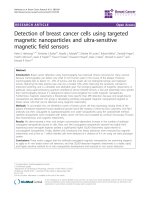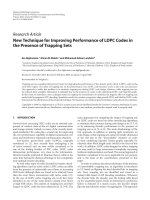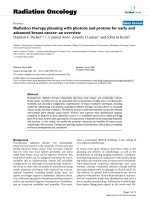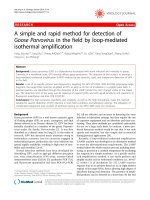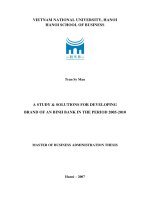BRCA1 Promoter Hypermethylation Signature for Early Detection of Breast Cancer in the Vietnamese Population
Bạn đang xem bản rút gọn của tài liệu. Xem và tải ngay bản đầy đủ của tài liệu tại đây (571.08 KB, 4 trang )
DOI: />BRCA1 Promoter Hypermethylation for Detection of Breast Cancer in Viet Nam
RESEARCH ARTICLE
BRCA1 Promoter Hypermethylation Signature for Early
Detection of Breast Cancer in the Vietnamese Population
Phuong Kim Truong1, Thuan Duc Lao1, Thao Phuong Thi Doan2, Thuy Ai Huyen
Le1*
Abstract
Breast cancer, a leading cause of death among women in most countries worldwide, is rapidly increasing in
incidence in Vietnam. One of biomarkers is the disruption of the genetic material including epigenetic changes
like DNA methylation. With the aim of finding hypermethylation at CpG islands of promoter of BRCA1 gene,
belonged to the tumor suppressor gene family, as the biomarker for breast cancer in Vietnamese population,
sensitive methyl specific PCR (MSP) was carried out on 115 samples including 95 breast cancer specimens and
20 normal breast tissues with other diseases which were obtained from Ho Chi Minh City Medical Hospital,
Vietnam. The result indicated that the frequency of BRCA1 hypermethylation reached 82.1% in the cases
(p<0.001). In addition, the DNA hypermethylation of this candidate gene increased the possibility to be breast
cancer with high incidence via calculated odd ratios (p<0.05). In conclusion, hypermethylation of this candidate
gene could be used as the promising biomarker application with Vietnamese breast cancer patients.
Keywords: BRCA1 - methylation - bisulfite modification - breast cancer
Asian Pac J Cancer Prev, 15 (22), 9607-9610
Introduction
In Vietnam, breast cancer is the most frequent
malignancy leading to the death for female, constituting
in certain has increased from a crude rate of 13.8 per
100,000 women in 2000 to 28.1 per 100,000 women
in 2010 (Nguyen at al., 2013). The early detection is
necessary to treat and improve the survival of breast cancer
patients. In patient with breast cancer, gene amplification
of HER2 which is a member of the epidermal growth
factor receptor family, is found to be present in 15-30%
newly diagnosed breast cancer cases and the mutations
in the tumor suppressor gene p53 is presented in 18%25% of primary breast carcinomas (Alsner at al., 2000;
Kotoe at el., 2009). The overexpression of the p53 and
HER-2/neu oncogenes are the two most common genetic
abnormalities associated with breast cancer (Alsner at el.,
2000). Besides, recently studies showed that the epigenetic
alterations, especially in tumor suppressor genes, that
initiate tumorgenesis could be used as the biomarkers for
the prognosis and diagnosis of neoplasm in body (Dulaimi
et al., 2004). So that, the objective of present study was to
determine the hypermethylation occurred in breast cancer
gene (BRCA1 gene), one of tumor suppressor genes,
applied in Vietnamese population.
Epigenetics changes, as DNA methylation is one of
the most common changes of epigenetics events, covalent
addition of the methyl group to DNA, which played an
important role in driving tumorgenesis (Pongtheerat et
al., 2011; Tanett et al., 2011; Fang et al., 2012; Fatemeh
et al., 2012; Ramezani et al., 2012; Wei-Jia et al., 2012).
The DNA methylation usually occurs in the CpG islands
located in or near the promoter of over 70% of all gene
(Tanett et al., 2011; Fatemeh et al., 2012; Wei-Jia et
al., 2012). In breast cancer, hypermethylation occurs in
BRCA1 gene’s promoter leaded to the cancer development
and progression (Evron et al., 2001; Xu et al., 2009; Kulis
at al., 2010; Ramezani et al., 2012). BRCA1 is identified at
17q12-21. Its protein, breast cancer type 1 susceptibility
protein is directly involved in preventing cells from
growing and dividing in a controlled way and repairing
damaged DNA. Recently, it is found that hypermethylation
in promoter CpG islands of BRCA1 leads to the loss of
expression of BRCA1, especially, in breast cancer (Xu et
al., 2009). According to the research of Hedenfalk et al.,
aberrant methylated of BRCA1 promoter is responsible for
functional inactivation of BRCA1 and plays an important
role in breast tumorigenesis (Hedenfalk et al., 2009).
In the present study, we determined quantitatively the
hypermethylation at CpG islands of promoter belongs to
BRCA1, in both Vietnamese breast cancer patients of all
stages from premalignant to advanced metastatic breast
Department of Biotechnology Applications in Medicine, Faculty of Biotechnology, Ho Chi Minh City Medicine and Pharmacy
University, 2Department of Pathological Anatomy, Faculty of Medicine, Vietnam *For correspondence:
1
Asian Pacific Journal of Cancer Prevention, Vol 15, 2014
9607
Phuong Kim Truong et al
tumor and healthy specimens by the MSP (Methylation
specific PCR) method.
unmethylated status for a given gene. Primer sequences
included methylated primers and unmethylated primers
were given in Table 1. Besides, the BRCA1 sequence,
CpG sites and transcriptional factors were showed in Fig
1. The amplifications were done in a total volume of 15μl,
containing 3μl bisulfite modified template DNA, 0.75
unit iTaq DNA polymerase (Biorad). MSP reaction was
subjected to initial incubation at 95oC for 5 min, followed
by 40 cycles at 95oC for 30s, 51oC for 30s, 72oC for 30s
and 72oC for 6 min for final incubation. Each PCR product
was directly loaded onto a 2.0% agarose gel, stained with
ethidium bromide, and directly visualized under UV
illumination.
Materials and Methods
Sample collection
A total of 115 samples were composed of 95 breast
cancer specimens that were enrolled in evaluating
predictive factors including immunohistochemistry with
two antibodies were HER2/neu and p53. HER2/neu status
was originally scored 0 to 3+, and 0 tumors were regarded
as HER2/neu negative. Moreover, the histologic grade and
tumor grade of tumor specimens were also determined
according to the American Joint Committee on Cancer 6th
Edition Guidelines; 20 healthy specimens were obtained
from women who underwent a biopsy of the mammary
gland because of mammographic screening and for whom
histology confirmed the present of only normal tissue.
Those patients had the well information about the clinical
and molecular characteristics of the tumors are given.
Among these patients, the median of age was 48 years old
(ranging from 25 to 88 years old). Moreover, the stages
of tumors were large in stage I, II, III and IV which were
accounted for 53 (55.8%), 27 (28.4%), 9 (9.5%) and 6
(6.3%) of 95 specimens. According to the tumor grade,
grade 1, 2 and 3 were 5 (5.3%), 55 (57.9%), 35 (36.8%) of
95 samples, respectively. For HER and p53 staining, HER
positive and p53 positive were detected in 59 (62.1%)
and 17 (17.0%), respectively. The sum of sample with
both HER and p53 negative was counted for 33 (28.7%)
of 95 breast cancer specimens. Otherwise, the both HER
and p53 positive was 82 (71.3%). All the samples were
admitted to the Ho Chi Minh city Medical Hospital in
Vietnam from 2010 to 2011. These tissues were obtained
from the surgical specimens and then, embedded in the
paraffin and stored at -20oC until the further used.
Statistical analysis
The status of methylation of BRCA1 gene were
calculated. Differences in the presence of methylation
were determined by a two sided Fisher test and Chi
squared tests for variables. The relative risk (RR),
associations between the methylated status of candidate
gene and breast cancer, as well as any correlation between
methylation status and other clinical parameters were
examined using the Chi-square test. Moreover, the Odd
ratio (OR) and 95% confidence intervals (CIs) were also
calculated. Statistical analyses were performed by using
Medcalc® Version 12.7.0.0. Statistical significance was
assumed at two-side p value of p<0.05.
Results
Methylation analysis
For evaluation of promoter of BRCA1 genes
methylation status, the MSP method was carried out for
95 breast cancer specimens and 20 healthy DNA samples.
According to the result, regarding to the tumor specimens,
the frequency of methylation and unmethylation of BRCA1
was 78 (82.1%), 17 (17.9%) of 95 (p<0.001), respectively.
For the healthy specimens, there was no any considerably
methylation occurred in BRCA1 gene’s promoter, counting
for 0% (p<0.001) (Figure 2). Moreover, the MSP product
sequencing was shown in Figure 3.
The correlation between the methylation frequencies
of the BRCA1 gene and clinicopathological parameters
in breast cancer
Chi quare analysis revealed that there were no
any significant differences between the methylation
of promoter of BRCA1 gene and clinicopathological
parameters including age, stage, tumor grade which were
shown in table 2 (p>0.05).
To evaluate the correlation between the DNA
methylation and protein expression including HER/
neu and p53, the immunochemical staining of HER,
p53 was carried out. The results were shown in table 2.
DNA bisulfite modification and Methylation assays
DNA extractions were performed by phenol chloroform
method (Chomczynski et al., 1987). In addition, DNA
modifications were carried out by the DNA modification
kit (Epitect Kit, Qiagen). Approximate 2 μg genomic DNA
of each sample is bisulfite-modified and purified, then, the
final precipitate was eluted in a volume of 20 μl. MSP used
specific primers to evaluate the situation of methylated and
Table 1. Methylation and Unmethylation BRCA1
Primer Sequences
Primer name
Primer Sequence (5’ – 3’)*
BRCA1 methylated (Forward)
BRCA1 methylated (Reverse)
BRCA1 unmethylated (Forward)
BRCA1 unmethylated (Reverse)
TCGTGGTAACGGAAAAGCGC
AACGAACTCACGCCGCGCAA
TTGTGGTAATGGAAAAGTGT
AACAAACTCACACCACACAA
Table 2. The Correlation between BRCA1 Gene’s Promoter Methylation and Clinicopathological Parameters
Characteristics Age
Stage
GradeHER/neu
p53 HER(-)p53(-)
≤ 48 > 48
I
II
III
IV 1
2
3 Positive Negative Positive Negative
Yes
No
BRCA1
U
116
11 6 00
0
143
9 26 19
16 19 16
M
38 40 42 21 9 65 4132
30
50
62
19 14 66
p value
0.35
0.27
0.070.310.02
0.0002
9608
Asian Pacific Journal of Cancer Prevention, Vol 15, 2014
DOI: />BRCA1 Promoter Hypermethylation for Detection of Breast Cancer in Viet Nam
the relative risk, odd ratio and the disease was found
significant at 95% confidence interval with the odd
ratio and relative risk were 183.91 (p<0.001) and 33.64
(p=0.01), respectively, with the strong association.
Discussion
Figure 1. BRCA1 Sequence, MSP Primer Sequences
and Transcription Factor Binding Site. Promoter is
black, 5’UTR is purple, exon 1a is red, CpG sites are green and
underlined nucleotides are chosen for primer designed
(A)
(B)
Figure 2. Methylation of BRCA1 Gene Analysis on
Some Clinical Samples by MSP. The MSP products are
68 bp. U: unmethylated; M: methylated; L: 50 kp Ladder; (+)
positive control; (-) negative control; (A) tumor specimens; (B)
non-cancer specimens
Figure 3. Sequencing Profile of Methylated of BRCA1.
CpG sites were in green highlight; The cytosine did not depend
on the CpG site were marked as the black triangle, the cytosine
depend on the CpG site were marked as the black circle; (a) DNA
sequence was without bisulfite modified; (b) DNA sequence
was bisulfite modified; (c) The BRCA1 sequencing by using the
forward methylated primer
The significant correlations were found out between the
methylation status of BRCA1 gene’s promoter with p53,
HER(-)p53(-) characteristic (p<0.05). As for the HER/neu
expression, there was no any signification was found out
(p=031). Therefore, according to our study, the results of
comparison of methylation frequency of candidate gene’s
promoter also showed the strong correlation between
the methylation frequency and breast cancer (p<0.05). It
meant that the mean concentration of methylated status
of BRCA1 gene’s promoter in breast cancer patient was
higher than in the normal healthy control groups, which
was statistically significant (p<0.05). Therefore, it could
be deduced that the methylation status in BRCA1 gene’s
promoter was the significant feature in breast cancer
tumorgenesis. In addition, to evaluate the applicability
of BRCA1 methylation in breast cancer patients as a
biomarker for breast cancer, the Chi2 test between
The find out the newly biomarker was the important
aim for the prognosis and diagnosis of breast cancer,
because the incident rate of breast cancer, especially in
Vietnamese population, has considerably increased with
a faster pace over past decades (Nguyen et al., 2013).
Therefore, the purpose of present study was to investigate
the methylation status of BRCA1 gene’s promoter in breast
cancer tumor in Vietnamese population. The methylation
of tumor suppressor gene, BRCA1, was early detectable,
which provided evidences for early diagnosis of tumor
(Manel et al., 2001; Ibanez at al., 2004). In this study, we
successfully carried out the evaluation of methylation
status of BRCA1, by sequencing, we observed total of
10 CpG sites which were totally methylated located at
the region of forward and reverse methylated primers
binding sites (Figure 3). Moreover, firstly, the signals of
peaks in MSP product sequencing were unique, clear and
specific. Secondly, making a comparison between DNA
sequence without bisulfite modified with DNA sequence
was bisulfite modified, a clearly results demonstrated
that all the unmethylated nucleotides were totally
conversed into uracil. Therefore, we concluded that the
bisulfite modification was successfully carried out. The
mean of BRCA1 methylated promoter frequency, in our
report, was 82.1% (78 of 95 tumor specimens). For the
BRCA1 promoter methylation, based on comparison
to the worldwide researches, in our study the mean of
frequency of hypermethylated BRCA1 was rather higher
than Tapia et al. (2008), Nicholas et al. (2013), William et
al. (2013) showing the methylation frequencies as 51%,
56% and 29%, respectively. Concerning to non-cancer
specimens or healthy specimens, the similar to those
studies was considered that no any methylation frequency
was found in BRCA1 gene’s promoter. In another word,
the hypermethylation of BRCA1 gene’s promoter was the
specific outcome of Vietnamese breast cancer patients.
Regarding to clinical parameters, in our report,
there were no any significant differences between the
hypermethylated BRCA1 promoter and the patient ages,
tumor grades and stages, according to the studies of
Nicolas et al. (2013), Valgerdur et al. (2006). Concerning
to HER/neu staining and BRCA1 methylation, based on
the results, it was clearly to consider that more than 75%
of positive HER/neu cases were methylation, contract
to negative HER/neu cases in which the methylated
status, counting for more than 65% was also higher than
unmethylated. Therefore, in addition to the statistical
analysis (p>0.05), it could be clearly included that there
was poor correlation between the HER/neu expression
and BRCA1 hypermethylation, according to Nicolas et
al. (2013). In addition, the overexpression of mutant p53
had been indicated that to have a considerable relationship
to the tumor rate, in our report, we conducted only the
frequent methylation of BRCA1 were associated to the
Asian Pacific Journal of Cancer Prevention, Vol 15, 2014
9609
Phuong Kim Truong et al
p53 stages (p=0.02). Especially, taken p53 and HER/neu
staining together, the mean of hypermethylated BRCA1
frequency was strongly associated with HER/neu(-)p53(-)
stage (p=0.0002), meant that the quantitative of marker
gene methylation were clearly associated as the useful
biomarker for classify and diagnosis for breast tumor.
According to the odd ratio and risk ratio showed in
table 2, it indicated that BRCA1 methylated was highly
correlated with breast cancer risk via the odd ratio with the
significant statistic with OR=183.91 at 95%CI (p<0.001).
It meant that in this model, the odds for a positive
hypermethylation of BRCA1 promoter in breast cancer
was 183.91 times higher than in the case of cancer without
methylation. In addition, the RR was 33.64 (p=0.01),
meant that the hypermethylation of BRCA1 gene’s
promoter was 33.64 times higher than unmethylation in
breast tumor. Based on these results, it was tentatively
inferred that the aberrant hypermethylation of BRCA1
promoter as the role of driving the breast tumorgenesis.
Consequently, the hypermethylation in BRCA1 gene’s
promoter could be useful phenomenon applied in early
detection of breast cancer in Vietnamese population.
In conclusion, in our study, we highlighted the
mean methylation BRCA1 gene’s promoter frequency
was 82.1%. This hypermethylation of candidate gene’s
promoter was the specific characteristic of Vietnamese
breast cancer patients, especially, strongly associated
with breast tumorgenesis. Furthermore, patients with the
hypermethylation in BRCA1 gene’s promoter were higher
than whom without methylation (OR=183.91 at 95%CI
(p<0.001)). Based on these data, increased understanding
of epigenetics changes as DNA hypermethylation in
BRCA1 may involve in pathogenesis of breast cancer and
provided the basic method for early detection. Besides,
these data could be inferred that the role of abnormal
methylation at CpG islands of promoter belonged to
BRCA1 information as a potential biomarker for early
diagnosis application in Vietnamese population. .
References
Alsner J, Yilmaz M, Guldberg P, Hansen LL, Overgaard J (2000).
Heterogeneity in the clinical phenotype of TP53 mutations in
breast cancer patients. Clin Cancer Res, 6, 3923-31.
Birgisdottir V, Stefansson OA, Bodvarsdottir SK, et al (2006).
Epigenetic silencing and deletion of the BRCA1 gene in
sporadic breast cancer. Breast Cancer Res, 8, 38.
Chomczynski P, Sacchi N (1987). Single-step method of
RNA isolation by acid guanidinium thiocyanate-phenolchloroform extraction. Anal Biochem, 162, 156-9.
Dulaimi E, Hillinck J, Ibanez de Caceres I, Al-Saleem T, Cairns
P (2004). Tumor suppressor gene promoter hypermethylation
in serum of breast cancer patients. Clin Cancer Res, 10,
6189-93.
Esteller M, Corn PG, Baylin SB, Herman JG (2001). A gene
hypermethylation profile of human cancer. Cancer Res,
61, 3225-9.
Evron E, Umbricht CB, Korz D, et al (2001). Loss of cyclin D2
expression in the majority of breast cancers is associated
with promoter hypermethylation. Cancer Res, 61, 2782-7.
Fang WJ, Zheng Y, Wu LM, et al (2012). Genome-wide analysis
of aberrant DNA methylation for identification of potential
biomarkers in colorectal cancer patients. Asian Pac J Cancer
9610
Asian Pacific Journal of Cancer Prevention, Vol 15, 2014
Prev, 13, 1917-21.
Hedenfalk I, Duggan D, Chen Y, et al (2001). Gene-expression
profiles in hereditary breast cancer. N Engl J Med, 344,
539-48.
Hoang Lan N, Laohasiriwong W, Stewart JF, Tung ND, Coyte
PC (2013). Cost of treatment for breast cancer in central
Vietnam. Glob Health Action, 6, 18872-81.
Hsu NC, Huang YF, Yokoyama KK, et al (2013). Methylation
of BRCA1 promoter region is associated with unfavorable
prognosis in women with early-stage breast cancer. PLoS
One, 8, 56256.
Ibanez de Caceres I, Battagli C, Esteller M, et al. (2004) Tumor
cell-specific BRCA1 and RASSF1A hypermethylation in
serum, plasma, and peritoneal fluid from ovarian cancer
patients. Cancer Res, 64, 6476-81.
Jacot W, Thezenas S, Senal R, et al (2013). BRCA1 promoter
hypermethylation, 53BP1 protein expression and PARP-1
activity as biomarkers of DNA repair deficit in breast cancer.
BMC Cancer, 13, 523.
Kulis M, Esteller M (2010). DNA methylation and cancer. Adv
Genet, 70, 27-56.
Pongtheerat T, Pakdeethai S, Purisa W, Chariyalertsak S, Petmitr
S (2011). Promoter methylation and genetic polymorphism
of glutathione S-transferase P1 gene (GSTP1) in Thai breastcancer patients. Asian Pac J Cancer Prev, 12, 2731-4.
Ramezani F, Salami S, Omrani MD, Maleki D (2012). CpG
island methylation profile of estrogen receptor alpha in
Iranian females with triple negative or non-triple negative
breast cancer: new marker of poor prognosis. Asian Pac J
Cancer Prev, 13, 451-7.
Tapia T, Smalley SV, Kohen P, et al (2008). Promoter
hypermethylation of BRCA1 correlates with absence of
expression in hereditary breast cancer tumors. Epigenetics,
3, 157-63.
Terada K, Okochi-Takada E, Akashi-Tanaka S, et al (2009).
Association between frequent CpG island methylation
and HER2 amplification in human breast cancers.
Carcinogenesis, 30, 466-71.
Xu X, Gammon MD, Zhang Y, et al (2009). BRCA1 promoter
methylation is associated with increased mortality among
women with breast cancer. Breast Cancer Res Treat, 115,
397-404.


